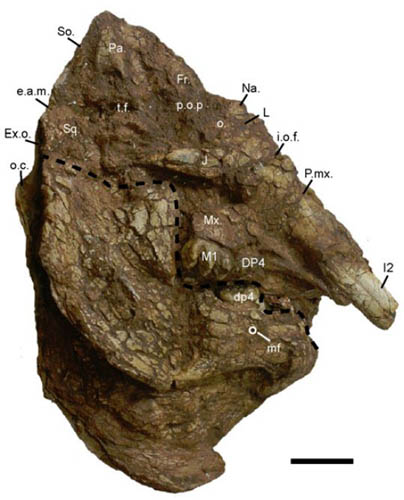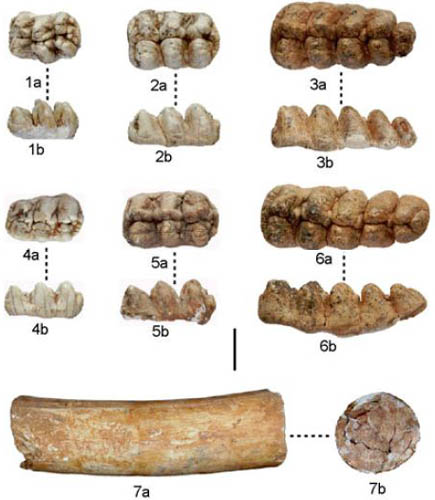| Location: Home > Research > Research Progress |
| New Species of Trilophodont Gomphotheres Found From the Quaternary of China |
|
According to an article published online December 2012 in the journal of Chinese Science Bulletin (Vol.57,No.36), Dr. JIN Changzhu, Institute of Vertebrate Paleontology and Paleoanthropology (IVPP), Chinese Academy of Sciences, and his team described a new species of trilophodont gomphotheres, Sinomastodon jiangnanensis, from the Early Pleistocene Renzidong Cave deposits in Anhui Province, Eastern China. The specimen, an almost complete skull with mandible and dentition, is the first discovery of a Quaternary Sinomastodon skull from China and has significant implications for discussing the evolution, dispersion and related paleoecological variation of Sinomastodon during the Quaternary. Gomphotheres are considered as the main clade of the mastodons and was one of the most successful groups of Proboscidea due to its wide geographic distribution across all continents except Antarctic and Australia, from the Early Miocene to the Late Pleistocene. Early members were characterized by long jaws that progressively evolved into the short-jawed types found in both the Old and New World. As the only brevirostrine (short and broad-jawed) trilophodont gomphothere known from the Old World, Sinomastodon was mainly indigenous to China from the Early Pliocene to the Pleistocene, but only a few single Pleistocene teeth were previously found in China. The Renzidong Paleolithic site discovered in 1998 is located near the south bank of the Yangtze River in Fanchang County, Anhui Province, Eastern China. This location lies in the transitional zone between the Palaearctic and Oriental zoogeographical regions. Systematic excavations of the cave have yielded numerous mammalian remains in association with stone and bone artifacts. Preliminary paleomagnetic dating shows that the age of the strata yielding Sinomastodon in Renzidong Cave is 2.14–2.15 million years ago. With a brevirostrine, elephant-like skull, no lower tusks, and simple bunodont and trilophodont intermediate molars, the new species is morphologically distinct from other gomphotheres and should be assigned to the genus Sinomastodon. Comparison studies indicate that the new species is more progressive than S. hanjiangensis and the Pliocene type species S. intermedius in its skull and mandible morphology, but is evidently more primitive than the Pleistocene S. yangziensis in its molar morphology. “The faunal analysis of the Renzidong fauna indicates a warm semi-arid and semi-humid forest-grassland environment. Obviously, this fauna has characteristics of a transitional zone with more typical northern types”, said WANG Yuan, first author of the study at the IVPP, “The large scale invasion of northern forms moving to the south implies a distinct cooling event at the beginning of the Quaternary, which resulted in a southward migration of Sinomastodon to the Jiangnan area and the speciation of S. jiangnanensis.” This work was supported by the Chinese Academy of Sciences, the National Natural Science Foundation of China, the China Geological Survey, and the Key Laboratory of Evolutionary Systematics of Vertebrates, CAS.  Fig.1 The skull and mandible of Sinomastodon jiangnanensis sp. nov. (IVPP V 18221), lateral view, scale equals 10 cm. (Image by WANG Yuan)  Fig.2 The molars and fragmentary upper incisor of Sinomastodon jiangnanensis sp. nov., scale equals 5 cm. (Image by WANG Yuan) |